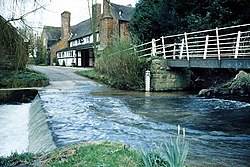Longnor, Shropshire
| Longnor | |
| Shropshire | |
|---|---|
 The ford at the Old Forge, Longnor | |
| Location | |
| Grid reference: | SJ485005 |
| Location: | 52°36’4"N, 2°45’22"W |
| Data | |
| Population: | 289 (2011[1]) |
| Post town: | Shrewsbury |
| Postcode: | SY5 |
| Dialling code: | 01743 |
| Local Government | |
| Council: | Shropshire |
| Parliamentary constituency: |
Shrewsbury and Atcham |
Longnor is a village and parish in Shropshire, located just off the A49 road south of Dorrington and north of Leebotwood. The village is notable for its medæval deer park, as well as the famous Shropshire Ghost, the White Lady of Longnor. The village is also home to Longnor Hall and St Mary's Church, a Grade-I-listed mediæval church.
The Cound Brook, a tributary of the River Severn flowing from the All Stretton area and entering the Severn near Cound, flows just to the west of the village and the mediæval deer park.
Regional Cycle Route 32/33 passes through Longnor, on its way from Little Ryton to All Stretton. As do a couple of bus routes on their way from Church Stretton to Shrewsbury and Radbrook Green. There is a primary school, Longnor CE Primary School, in the village and the nearest secondary school is in Church Stretton.[2]
Church


St Mary's church is an ancient building in the Early English style. In the year 2000 it had two new stained-glass windows fitted.
Originally a chapel to Condover it was then turned into a chapel for the Corbett family of Longnor Hall before eventually evolving into the parish church.[3]
Longnor was the birthplace of Samuel Lee (1783–1853), a linguist, Cambridge academic and Anglican cleric whose translations of the Bible and other religious works into Arabic and other languages helped to launch the missionary activities of the Evangelical movement in the first half of the 19th century.[4]
Longnor Hall
- Not to be confused with Longner Hall, near Shrewsbury
Longnor Hall features a park and formal gardens, the park originated in the 14th Century. In the 17th century it was turned from being a park to having formal gardens laid out. It is now left with having the 18th Century park and modern gardens still in survival.[5] The current hall was built by Sir Richard Corbett in 1670 as successor for Roger Sprencheaux's fortified manor house from 1235.[6] The hall had some alterations done between 1838 and 1842 by the architect and builder Edward Haycock Snr.[7][8]
Corbet Family
The Corbett Family were the builders and original inhabitants of Longnor Hall. Originally built for Sir Richard Corbett in 1670 and finished in 1693 for his son, Uvedale Corbett, in 1694.[7] The name of Corbet arrived in Shropshire in the times of the Norman Conquest, when Hugh Corbet settled in the area. The name developed from Corbet, to Corbett, and the branch of the Corbett family living in Longnor dates from the 1500s. The last in this line was Jane Corbett who married archdeacon Joseph Plymley, however he took on the name Corbett and it has continued on. However many Corbets or Corbetts by the 19th Century had moved away from Shropshire.[9]
Natural Features
Cound Brook
Cound Brook is a 25-mile long tributary of the River Severn, it runs from the All Stretton area, through Longnor, Condover and exits into the Severn near Cound. Longnor is situated in the middle section of Cound Brook. Having rainwater runoff from the Stretton Hills join it, the brook rapidly widens to a significant flow, passing to the east of Leebotwood and west of Longnor and the Mediæval deer park there. Continuing to the east of Dorrington village, at Stapleton the Cound changes direction and heads eastwards. The flow of the Cound Brook can vary from a slow, sluggish flow in a dry summer to a raging torrent in winter or spring.[10]

Mediæval Deer Park
A mediæval deer park was an enclosed area containing deer. It was bounded by a ditch and bank with a wooden park pale on top of the bank. The ditch was typically on the inside,[11] thus allowing deer to enter the park but preventing them from leaving.
Shropshire Ghost
- The White Lady of Longnor
The White Lady of Longnor is one of Shropshire's most famous ghost stories. She allegedly appears clothed in her long white wedding dress. Her haunt is on or near the road bridge near the village, she is thought to have thrown herself from the old bridge into the water below after being deserted at the altar. She is rumoured to stand staring at the water as it flows beneath her feet. There are various accounts of what she appears to do, one is that she will drift eerily through the parapet of the bridge and fall slowly into the stream then fade away. Another claims that she attends village dances and parties.[12]
References
- ↑ "Civil Parish population 2011". http://www.neighbourhood.statistics.gov.uk/dissemination/LeadKeyFigures.do?a=7&b=11126082&c=Longnor&d=16&e=62&g=6460841&i=1001x1003x1032x1004&m=0&r=1&s=1448711134316&enc=1. Retrieved 28 November 2015.
- ↑ OFSTED
- ↑ http://www.achurchnearyou.com/longnor-st-mary/
- ↑ Nile Green: Terrains of Exchange. Religious Economies of Global Islam (London: C. Hurst & Co., 2014), pp. 59–64.
- ↑ http://www.parksandgardens.ac.uk/component/option,com_parksandgardens/task,site/id,6300/Itemid,292/
- ↑ http://www.melocki.org.uk/salop/Longnor.html
- ↑ 7.0 7.1 http://www.britishlistedbuildings.co.uk/en-259606-longnor-hall-longnor
- ↑ http://www.tkellner.com/index.php?id=3344
- ↑ http://www.selectsurnames.com/corbett.html
- ↑ [1]
- ↑ Rackham, Oliver (1976). Trees and Woodland in the British Landscape. Archaeology in the Field Series. London: J.M. Dent & Sons Ltd. p. 150. ISBN 0 460 04183 5.
- ↑ http://www.shropshirestar.com/news/2011/10/31/shropshire-%E2%80%93-a-haunted-haven/
Outside links
| ("Wikimedia Commons" has material about Longnor, Shropshire) |
